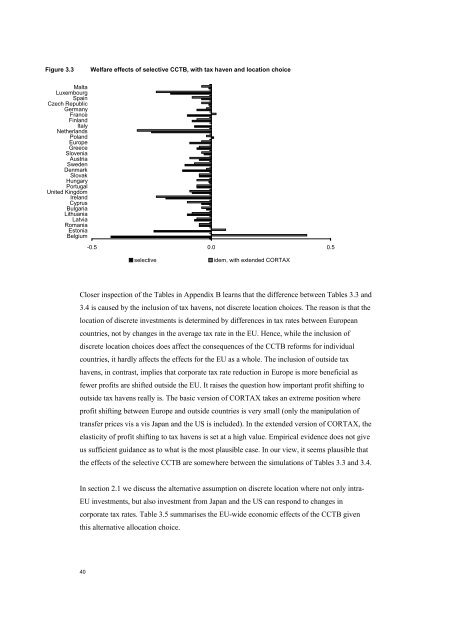The economic effects of EU-reforms in corporate income tax systems
The economic effects of EU-reforms in corporate income tax systems
The economic effects of EU-reforms in corporate income tax systems
Create successful ePaper yourself
Turn your PDF publications into a flip-book with our unique Google optimized e-Paper software.
Figure 3.3<br />
Welfare <strong>effects</strong> <strong>of</strong> selective CCTB, with <strong>tax</strong> haven and location choice<br />
Malta<br />
Luxembourg<br />
Spa<strong>in</strong><br />
Czech Republic<br />
Germany<br />
France<br />
F<strong>in</strong>land<br />
Italy<br />
Netherlands<br />
Poland<br />
Europe<br />
Greece<br />
Slovenia<br />
Austria<br />
Sweden<br />
Denmark<br />
Slovak<br />
Hungary<br />
Portugal<br />
United K<strong>in</strong>gdom<br />
Ireland<br />
Cyprus<br />
Bulgaria<br />
Lithuania<br />
Latvia<br />
Romania<br />
Estonia<br />
Belgium<br />
-0.5 0.0 0.5<br />
selective<br />
idem, with extended CORTAX<br />
Closer <strong>in</strong>spection <strong>of</strong> the Tables <strong>in</strong> Appendix B learns that the difference between Tables 3.3 and<br />
3.4 is caused by the <strong>in</strong>clusion <strong>of</strong> <strong>tax</strong> havens, not discrete location choices. <strong>The</strong> reason is that the<br />
location <strong>of</strong> discrete <strong>in</strong>vestments is determ<strong>in</strong>ed by differences <strong>in</strong> <strong>tax</strong> rates between European<br />
countries, not by changes <strong>in</strong> the average <strong>tax</strong> rate <strong>in</strong> the <strong>EU</strong>. Hence, while the <strong>in</strong>clusion <strong>of</strong><br />
discrete location choices does affect the consequences <strong>of</strong> the CCTB <strong>reforms</strong> for <strong>in</strong>dividual<br />
countries, it hardly affects the <strong>effects</strong> for the <strong>EU</strong> as a whole. <strong>The</strong> <strong>in</strong>clusion <strong>of</strong> outside <strong>tax</strong><br />
havens, <strong>in</strong> contrast, implies that <strong>corporate</strong> <strong>tax</strong> rate reduction <strong>in</strong> Europe is more beneficial as<br />
fewer pr<strong>of</strong>its are shifted outside the <strong>EU</strong>. It raises the question how important pr<strong>of</strong>it shift<strong>in</strong>g to<br />
outside <strong>tax</strong> havens really is. <strong>The</strong> basic version <strong>of</strong> CORTAX takes an extreme position where<br />
pr<strong>of</strong>it shift<strong>in</strong>g between Europe and outside countries is very small (only the manipulation <strong>of</strong><br />
transfer prices vis a vis Japan and the US is <strong>in</strong>cluded). In the extended version <strong>of</strong> CORTAX, the<br />
elasticity <strong>of</strong> pr<strong>of</strong>it shift<strong>in</strong>g to <strong>tax</strong> havens is set at a high value. Empirical evidence does not give<br />
us sufficient guidance as to what is the most plausible case. In our view, it seems plausible that<br />
the <strong>effects</strong> <strong>of</strong> the selective CCTB are somewhere between the simulations <strong>of</strong> Tables 3.3 and 3.4.<br />
In section 2.1 we discuss the alternative assumption on discrete location where not only <strong>in</strong>tra-<br />
<strong>EU</strong> <strong>in</strong>vestments, but also <strong>in</strong>vestment from Japan and the US can respond to changes <strong>in</strong><br />
<strong>corporate</strong> <strong>tax</strong> rates. Table 3.5 summarises the <strong>EU</strong>-wide <strong>economic</strong> <strong>effects</strong> <strong>of</strong> the CCTB given<br />
this alternative allocation choice.<br />
40
















